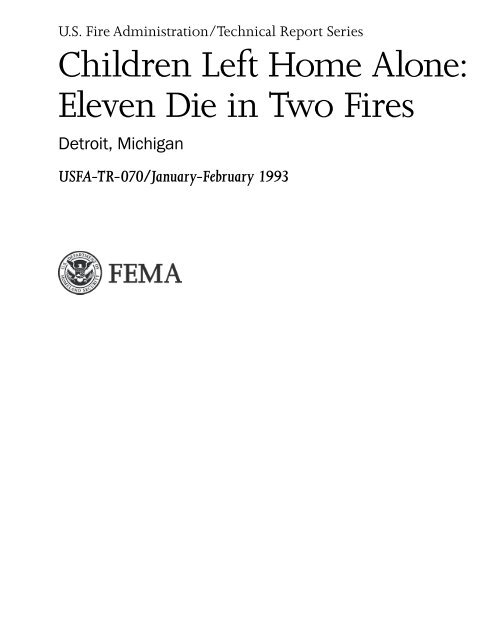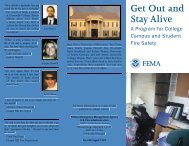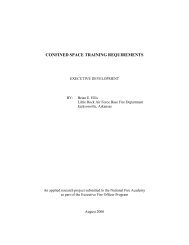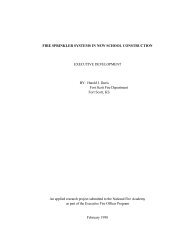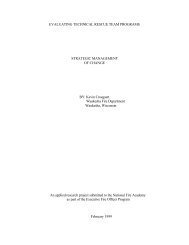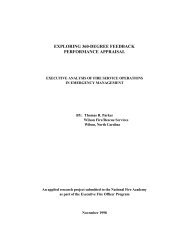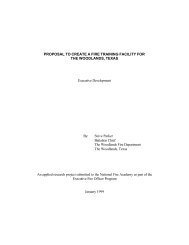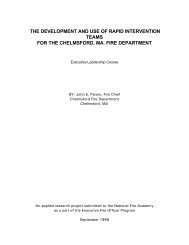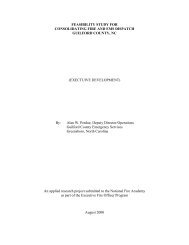TR-070 Children Left Home Alone - US Fire Administration - Federal ...
TR-070 Children Left Home Alone - US Fire Administration - Federal ...
TR-070 Children Left Home Alone - US Fire Administration - Federal ...
You also want an ePaper? Increase the reach of your titles
YUMPU automatically turns print PDFs into web optimized ePapers that Google loves.
U.S. <strong>Fire</strong> <strong>Administration</strong>/Technical Report Series<br />
<strong>Children</strong> <strong>Left</strong> <strong>Home</strong> <strong>Alone</strong>:<br />
Eleven Die in Two <strong>Fire</strong>s<br />
Detroit, Michigan<br />
<strong>US</strong>FA-<strong>TR</strong>-<strong>070</strong>/January-February 1993
U.S. <strong>Fire</strong> <strong>Administration</strong> <strong>Fire</strong> Investigations Program<br />
The U.S. <strong>Fire</strong> <strong>Administration</strong> develops reports on selected major fires throughout the country.<br />
The fires usually involve multiple deaths or a large loss of property. But the primary criterion<br />
for deciding to do a report is whether it will result in significant “lessons learned.” In some<br />
cases these lessons bring to light new knowledge about fire--the effect of building construction or<br />
contents, human behavior in fire, etc. In other cases, the lessons are not new but are serious enough<br />
to highlight once again, with yet another fire tragedy report. In some cases, special reports are developed<br />
to discuss events, drills, or new technologies which are of interest to the fire service.<br />
The reports are sent to fire magazines and are distributed at National and Regional fire meetings. The<br />
International Association of <strong>Fire</strong> Chiefs assists the <strong>US</strong>FA in disseminating the findings throughout the<br />
fire service. On a continuing basis the reports are available on request from the <strong>US</strong>FA; announcements<br />
of their availability are published widely in fire journals and newsletters.<br />
This body of work provides detailed information on the nature of the fire problem for policymakers<br />
who must decide on allocations of resources between fire and other pressing problems, and within<br />
the fire service to improve codes and code enforcement, training, public fire education, building<br />
technology, and other related areas.<br />
The <strong>Fire</strong> <strong>Administration</strong>, which has no regulatory authority, sends an experienced fire investigator<br />
into a community after a major incident only after having conferred with the local fire authorities<br />
to insure that the assistance and presence of the <strong>US</strong>FA would be supportive and would in no way<br />
interfere with any review of the incident they are themselves conducting. The intent is not to arrive<br />
during the event or even immediately after, but rather after the dust settles, so that a complete and<br />
objective review of all the important aspects of the incident can be made. Local authorities review<br />
the <strong>US</strong>FA’s report while it is in draft. The <strong>US</strong>FA investigator or team is available to local authorities<br />
should they wish to request technical assistance for their own investigation.<br />
This report and its recommendations were developed by <strong>US</strong>FA staff and by TriData Corporation,<br />
Arlington, Virginia, its staff and consultants, who are under contract to assist the <strong>US</strong>FA in carrying<br />
out the <strong>Fire</strong> Reports Program.<br />
The <strong>US</strong>FA greatly appreciates the cooperation received from the Detroit <strong>Fire</strong> Department, particularly<br />
Deputy Commissioner Marvin Beatty and other department members who provided valuable information<br />
for this report.<br />
For additional copies of this report write to the U.S. <strong>Fire</strong> <strong>Administration</strong>, 16825 South Seton<br />
Avenue, Emmitsburg, Maryland 21727. The report is available on the <strong>US</strong>FA Web site at http://<br />
www.usfa.dhs.gov/
<strong>Children</strong> <strong>Left</strong> <strong>Home</strong> <strong>Alone</strong>:<br />
Eleven Die in Two <strong>Fire</strong>s<br />
Detroit, Michigan<br />
Investigated by: Mark Chubb<br />
This is Report <strong>070</strong> of the Major <strong>Fire</strong>s Investigation Project conducted<br />
by TriData Corporation under contract EMW-90-C-3338 to the United<br />
States <strong>Fire</strong> <strong>Administration</strong>, <strong>Federal</strong> Emergency Management Agency.<br />
Department of <strong>Home</strong>land Security<br />
United States <strong>Fire</strong> <strong>Administration</strong><br />
National <strong>Fire</strong> Data Center
U.S. <strong>Fire</strong> <strong>Administration</strong><br />
Mission Statement<br />
As an entity of the Department of <strong>Home</strong>land<br />
Security, the mission of the <strong>US</strong>FA is to re-<br />
duce life and economic losses due to fire<br />
and related emergencies, through leader-<br />
ship, advocacy, coordination, and support.<br />
We serve the Nation independently, in co-<br />
ordination with other <strong>Federal</strong> agencies,<br />
and in partnership with fire protection and<br />
emergency service communities. With a<br />
commitment to excellence, we provide pub-<br />
lic education, training, technology, and data<br />
initiatives.
TAbLE oF ConTEnTS<br />
OVERVIEW . . . . . . . . . . . . . . . . . . . . . . . . . . . . . . . . . . . . . . . . . . . . . . . . . . . . . . . . . . . . . . . . . 1<br />
SummaRy Of KEy ISSuES ..................................................... 2<br />
THE DE<strong>TR</strong>OIT fIRES .......................................................... 4<br />
The Sheridan Street <strong>Fire</strong> . . . . . . . . . . . . . . . . . . . . . . . . . . . . . . . . . . . . . . . . . . . . . . . . . . . . . 4<br />
The Mack Street <strong>Fire</strong> ........................................................ 4<br />
fIRE RISK . . . . . . . . . . . . . . . . . . . . . . . . . . . . . . . . . . . . . . . . . . . . . . . . . . . . . . . . . . . . . . . . . . 5<br />
<strong>Children</strong> in Self-Care ........................................................ 6<br />
Relative <strong>Fire</strong> Risk . . . . . . . . . . . . . . . . . . . . . . . . . . . . . . . . . . . . . . . . . . . . . . . . . . . . . . . . . . 6<br />
Juvenile <strong>Fire</strong>setting Behavior .................................................. 8<br />
REmEDIES .................................................................. 9<br />
Criminal Statutes ........................................................... 9<br />
Public <strong>Fire</strong> Safety Education . . . . . . . . . . . . . . . . . . . . . . . . . . . . . . . . . . . . . . . . . . . . . . . . . 10<br />
Product Design Standards . . . . . . . . . . . . . . . . . . . . . . . . . . . . . . . . . . . . . . . . . . . . . . . . . . . 11<br />
aNaLySIS . . . . . . . . . . . . . . . . . . . . . . . . . . . . . . . . . . . . . . . . . . . . . . . . . . . . . . . . . . . . . . . . . 11<br />
LESSONS LEaRNED .......................................................... 12<br />
REfERENcES ............................................................... 14<br />
appENDIx a: floor plans for 2258 mack Street, Detroit, michigan . . . . . . . . . . . . . . . . . . . . 16<br />
appENDIx B: photographs of 2258 mack Street, Detroit, michigan .................... 18
<strong>Children</strong> <strong>Left</strong> <strong>Home</strong> <strong>Alone</strong>:<br />
Eleven Die in Two <strong>Fire</strong>s<br />
Detroit, Michigan<br />
January-February 1993<br />
Local Contacts: Deputy Commissioner Marvin Beatty<br />
<strong>Fire</strong> Marshal L. Richard Milliner<br />
Chief of Arson Charles Evancho<br />
Battalion Chief Rodney Parnell<br />
Captain Jon Bozich<br />
Lieutenant Cohn Prentice<br />
Detroit <strong>Fire</strong> Department<br />
250 West Larned Street<br />
Detroit, Michigan 48226<br />
(313) 596-2900<br />
oVERVIEW<br />
Two Detroit, Michigan, fires are among a group of incidents in the early months of 1993 which<br />
raised the Nation’s awareness of the problem of unsupervised children. These incidents, which<br />
occurred less than a month apart, resulted in the deaths of 11 children under the age of 10. The<br />
causes of these fires and the factors which led to the tragic loss of these young lives provide vivid<br />
lessons about the dangers of leaving children home alone.<br />
In the first fire, on January 14, a mother left four of her young children alone while she answered<br />
a telephone call at a neighbor’s home. In the short time she was away, perhaps 10 to 15 minutes, a<br />
pot of food on the stove ignited. The fire spread to combustible cabinets and interior finish, growing<br />
until it reached flashover. The four children died.<br />
The other fire, February 17, resulted when embers from burning newspapers which were being used<br />
to thaw a frozen water line under the wood-frame house, ignited the structure. The fire cut off the<br />
only useable exit. Seven children, ranging in age from 7 months to 9 years, lost their lives when they<br />
were unable to escape. The front door of the dwelling was secured with bars and a high-security<br />
padlock, while all of the windows except one was covered with bars, mesh security grilles, or were<br />
otherwise blocked, preventing escape. The window in the room where the children’s bodies were<br />
found was not blocked by security grilles but was covered by a wood panel door held in-place by a<br />
large dresser. The parents of the seven children who died allegedly left the children alone for about<br />
45 minutes while they scavenged abandoned buildings for copper pipe to sell to repay a debt.<br />
1
2 U.S. <strong>Fire</strong> <strong>Administration</strong>/Technical Report Series<br />
SUMMARy oF KEy ISSUES<br />
Issue Comment<br />
<strong>Fire</strong> Risk <strong>Children</strong> under the age of 5 have the highest risk of dying in fire of all groups except<br />
adults 75 years of age or older.<br />
Unsupervised <strong>Children</strong> Estimates vary widely, but experts generally agree that millions of children are left home<br />
alone some of the time.<br />
<strong>Fire</strong> Causes Unsupervised children are vulnerable to fires of all causes but are particularly susceptible<br />
to fires involving child fire play, juvenile firesetting, and unattended cooking.<br />
Security Parents who find it necessary to leave children home alone often fear threats to their<br />
children’s security more than the danger of fire. Even bars, grilles, and special locking<br />
arrangements that can be opened from the inside may be difficult for children to operate.<br />
<strong>Fire</strong> Safety Education The unique responsibilities of parents and other child caregivers must be addressed in<br />
public fire education programs. Juvenile firesetter intervention programs should also be<br />
available within the community.<br />
Criminal Prosecution State criminal statutes set varying standards for neglect and abuse. Parents or guardians<br />
whose children die in fires while unsupervised may be subject to prosecution under<br />
manslaughter statutes.<br />
Product Design Efforts are underway to establish <strong>Federal</strong> standards for child-resistant disposable lighters<br />
to reduce the hazards of child fire play at least from that source.<br />
These fires clearly illustrate the tragic consequences which may result when children are left unsupervised.<br />
While other factors contributed to both the occurrence of these fires and the inability of<br />
the children to escape, the victims of these fires are not unlike millions of children left home alone<br />
across the United States. Other cases documented in the press around the time of the two fires in<br />
Detroit illustrate that this problem crosses economic and social barriers and affects children in many<br />
communities.<br />
December 21, 1992 (Kane County, Illinois) – Emergency dispatchers in suburban Kane County near<br />
Chicago, Illinois, were called about a smoke detector activation. A 6-year-old girl left home alone<br />
with her 4-year-old sister had gone to a neighbor’s house to summon help after water from an overfilled<br />
bathtub caused a smoke detector to short circuit. Sheriff’s deputies took the girls into protective<br />
custody when they learned that the children’s parents were vacationing in Acapulco, Mexico, for<br />
nine days over the Christmas holidays. When the parents returned to the United States on December<br />
30, they were arrested and charged on 64 counts, including child neglect, child abuse, and child<br />
abandonment.<br />
This case received the most attention in the national news media, but a growing number of similar<br />
cases fueled a debate, which came to involve the fire service, about what constitutes child neglect, at<br />
what age a child is responsible enough to be left without supervision, how long can a child be left<br />
alone before it constitutes abandonment, and what should be done about parents who neglect their<br />
children in this manner. The Illinois case did not involve a fire, and although the children were in no<br />
immediate danger, the fire service was notified in the process of resolving the incident. Other cases<br />
have resulted in the deaths of children. In some, injuries and deaths were only narrowly averted.<br />
February 2, 1993 (San Antonio, Texas) – A 13-month-old boy died six days later from injuries he sustained<br />
in a fire accidentally set by his 4-year-old brother while playing with a lighter. The 4-year-old
<strong>US</strong>FA-<strong>TR</strong>-<strong>070</strong>/January-February 1993 3<br />
was able to escape and notify neighbors who called the fire department. The two boys had been left<br />
home alone because their mother, a hotel housekeeper, could not afford day care services.<br />
February 5, 1993 (Milwaukee, Wisconsin) – <strong>Fire</strong>fighters found six children abandoned by their mother<br />
when they responded to a fire which started when one of the children put paper in a toaster oven.<br />
The oldest child, a 10-year-old girl, told authorities that she had last seen her mother the day before<br />
the fire, and that she and her five younger siblings were often left alone for days at a time. Police<br />
issued a warrant for the woman’s arrest when she could not be located.<br />
February 6, 1993 (Farmington Hills, Michigan) – Five-year-old twin brothers were found locked behind<br />
chained doors in separate bedrooms. Police and firefighters were summoned after a delivery driver<br />
noticed the two children banging on windows calling for help. <strong>Fire</strong>fighters forced entry through the<br />
windows to rescue the children when no one answered the door. The children’s mother was running<br />
errands at the time and advised police that she had locked the children in their rooms to make<br />
sure they stayed there and to keep her ex-husband away from them. Both children were placed in<br />
the care of the State Department of Social Services.<br />
February 8, 1993 (Des Moines, Iowa) – Six children were found unsupervised in an apartment with all<br />
of the burners on the stove turned on. The children were found, unsupervised for hours, after a<br />
babysitter had left them alone. The bathroom was also locked.<br />
February 9, 1993 (Carteret, New Jersey) – A boy and girl, ages 4 years and 17 months, were found unconscious<br />
by firefighters responding to their home for a fire caused by unattended cooking. A neighbor<br />
summoned the fire department when she heard one of the children calling “Daddy! Daddy!” and<br />
saw smoke pouring from the apartment. The children’s parents had left the kids home alone while<br />
making a trip to a nearby supermarket.<br />
March 1, 1993 (Miami, Florida) – A 6-year-old disabled girl died in a fire started by her 5-year-old<br />
brother. The two children and their 3-year-old sister were left alone for about 20 minutes while<br />
their mother was at a nearby coin laundry. The boy set a living room sofa on fire while playing with<br />
matches. A smoke detector above the sofa activated, alerting a neighbor who rescued the boy and<br />
notified the fire department. <strong>Fire</strong>fighters rescued the 3-year-old and found the 6-year-old on the<br />
living room floor but were unable to revive her.<br />
March 8, 1993 (Houston, Texas) – A 4-year-old boy left home alone with his 4-month-old sister died<br />
after setting fire to clothing in a closet. The 4-month-old girl was rescued by firefighters and was<br />
hospitalized and treated for smoke inhalation. Two older children, ages 8 and 11, were at school<br />
when the fire occurred. The children’s mother reportedly left the youngsters alone while running an<br />
errand. Investigators believe she was gone for approximately one hour when the fire was discovered<br />
by neighbors. Investigators revealed that the boy had set other fires in the past but had not received<br />
counseling for his firesetting behavior.<br />
According the Harris County <strong>Children</strong>’s Protective Services authorities, the woman was on probation<br />
for a drug-related conviction at the time of the fire. While she was incarcerated as a result of her<br />
arrest, the three oldest children were in protective custody.<br />
March 13, 1993 (Toledo, Ohio) – Two children, ages 9 and 10, died in an early morning house fire<br />
which started when an overturned electric space heater ignited their bedding. When the children<br />
were awakened by the fire, they tried to smother it with clothing and then sought refuge in a closet.<br />
Their 11-year-old brother, also in the room when the fire started, was burned but managed to escape
4 U.S. <strong>Fire</strong> <strong>Administration</strong>/Technical Report Series<br />
and call the fire department. The children’s mother had left them alone overnight, and she now faces<br />
involuntary manslaughter and child endangerment charges.<br />
THE DE<strong>TR</strong>oIT FIRES<br />
The two fires in Detroit, Michigan, January 14 and February 17, 1993, illustrate the danger of leaving<br />
children alone even for relatively short periods of time. The first case is an example of what can<br />
happen in a moment of distraction or inattention. The second fire illustrates the consequences of<br />
lack of parental supervision when other fire safety problems exist.<br />
The Sheridan Street fire<br />
On the afternoon of January 14, a young mother was called to a neighbor’s home to answer a telephone<br />
call concerning her 5-month-old son, who was in critical condition in the children’s intensive<br />
care unit of a local hospital after receiving an organ transplant. She ran to the neighbor’s house to<br />
take the call, leaving her other four children – ages 2 through 5 – alone in the house. She also left a<br />
pan of food cooking on the stove.<br />
Less than 15 minutes later the kitchen of this single-family home was in flames. Would-be rescuers<br />
from nearby houses were unable to enter the house to reach the children. When firefighters arrived,<br />
the fire had already spread to other rooms on the first floor of the home and was venting from the<br />
first floor windows and doors.<br />
Although the fire was controlled relatively quickly, the damage was already done. The four children<br />
were found dead on the second floor.<br />
The mack Street fire<br />
The afternoon of February 17, was a particularly cold one in Detroit. Temperatures had plummeted<br />
overnight and hovered in the low teens during the day with high winds and occasional snow<br />
showers.<br />
The house at 2258 Mack Street was a 1 1/2-story wood-frame structure built in the early 1870s. It<br />
was located in an economically-depressed neighborhood on the city’s east side; the lots on either<br />
side of the house were vacant.<br />
The cold temperatures and lack of adequate insulation in the building’s crawl space beneath the<br />
house caused pipes under the kitchen sink to freeze overnight. Sometime in the early afternoon, the<br />
adult male resident of the home opened an access panel on the side of the house, entered the crawl<br />
space, and began attempting to thaw the frozen pipes. To do this, he fashioned torches from rolled<br />
newspapers and lit them on fire. The lit newspapers were then held close enough for the flames to<br />
contact the water pipes, which were fastened to the floor joists.<br />
While he was working under the house another man drove up to the house, walked up to the access<br />
panel, and asked the first man to come out to discuss an unpaid debt. The second man offered to<br />
help the first man and his wife collect money to replay the debt by taking them to salvage copper<br />
pipe from some nearby abandoned buildings. A witness, who was in the area at the time, told investigators<br />
that she saw the man and his wife leave with the second man in his automobile. The children<br />
were left alone inside the house.
<strong>US</strong>FA-<strong>TR</strong>-<strong>070</strong>/January-February 1993 5<br />
According to witnesses, the seven children, ranging in age from 7 months to 9 years, were often left<br />
alone for extended periods of time by their parents. Although three of the children were of school<br />
age, on the day of the fire, a Thursday, all of the children were at home when at approximately 2:00<br />
p.m. passersby noticed smoke coming from the building and called the fire department.<br />
<strong>Fire</strong>fighters from Engine 6 and Ladder 10, located about 10 blocks away, responded with two other<br />
engine companies, another truck company, a rescue squad, and a battalion chief. When Engine 6<br />
and Ladder 10 arrived on the scene two minutes after the alarm was transmitted, fire was venting<br />
from the windows on the southwest side and rear of the house and thick smoke was pouring from<br />
the other openings. See Appendix A for the floor plan of the house.) A bystander told arriving<br />
firefighters that children were trapped inside – possibly in the living room, confirming information<br />
transmitted to them over the alarm printer in the station when they were dispatched.<br />
They tried to enter the house through the front door but found it secured with a heavy iron gate and<br />
high-security padlock. Of the two front windows of the house, the east window was covered with<br />
a security grate and the west window was obstructed by bicycles and other items stacked in front<br />
of it on the inside. Similarly, the windows on the southwest side of the house were covered by bars<br />
or security grates. On the northeast side of the house, only the window at the north end was not<br />
covered by bars or grates, but it was blocked by a panel door placed over it on the inside. As a result<br />
of these security devices and obstructions, firefighters were forced to enter the house through the<br />
rear doorway right where the fire had started and was most intense.<br />
<strong>Fire</strong>fighters from one company advanced through the kitchen and dining room to the living room<br />
to begin searching where the children were last seen by bystanders. Another crew fought through<br />
the kitchen and bathroom to begin searching the attic. Within minutes, firefighters had brought the<br />
fire under control and discovered the bodies of the seven children in the front bedroom, located just<br />
off of the living room.<br />
Investigators believe that the children, led by the 9-year-old, sought refuge in the front bedroom<br />
because it was remote from the fire. Most of the windows were blocked or locked, and the back<br />
door in the kitchen was blocked by the fire. Although the bedroom sustained almost no fire damage,<br />
it could not provide refuge from the choking smoke produced when the fire reached flashover in<br />
the kitchen.<br />
The parents returned approximately 20 minutes after firefighters arrived on the scene. Although fire<br />
investigators had probable cause to arrest the parents for child neglect and involuntary manslaughter,<br />
they were taken by Detroit EMS to the hospital where the children were transported from the fire<br />
scene. There the parents identified the bodies and were taken into custody by Detroit police officers<br />
who had determined that the woman was wanted on an outstanding arrest warrant. Detroit Police<br />
Department homicide detectives held the parents for almost 48 hours for questioning before releasing<br />
them for their children’s funerals.<br />
FIRE RISK<br />
To understand the fire risks associated with leaving children unsupervised, it is important to understand<br />
how common it is for children to be left home alone. The large number of children in selfcare<br />
arrangements must then be weighed against the relative risk of fire deaths and injuries among<br />
children and the causes of the fires which result in those injuries and deaths.
6 U.S. <strong>Fire</strong> <strong>Administration</strong>/Technical Report Series<br />
children in Self-care<br />
A number of studies in the past decade have focused on the special problems of latchkey children.<br />
The practice of leaving children home alone during the period between the end of the school day<br />
and the return of one or both parents from work – often two or three hours – is common in the<br />
United States. The practice of leaving even younger children home alone or in the care of children<br />
under 15 years of age is also prevalent. Studies by the U.S. Bureau of the Census (O’Connell and<br />
Bachu, 1992) and the former Department of Health, Education and Welfare (now the Department of<br />
Health and Human Services and Department of Education) present widely different estimates of the<br />
actual number of children in self-care arrangements, but experts have concluded that the number<br />
is probably in the millions, possibly approaching 10 million youngsters under the age of 13. One<br />
study by the Child Welfare League of America (Kraizer, Whitte, and Fryer, 199) places the number of<br />
children between 5 and 9 years of age left home alone as high as 8 million, and when older children<br />
are included, the number rises to 27 million.<br />
National estimates of the number of young children, under 5 years of age, who are left alone or<br />
in the care of older siblings are not available. However, a sense of the problem can be obtained<br />
by considering one community, Harris County, Texas. Here, in 1993, <strong>Children</strong> Protective Services<br />
(in Houston) investigated 1,942 cases of unsupervised preschoolers (each family is a separate case<br />
regardless of the number of complaints or number of children in the household).<br />
The increase in the number of single-parent households and families where both parents work fulltime<br />
is almost certainly driving up the numbers of home alone youngsters.<br />
The impact of this trend is unclear. Bethesda, Maryland, Clinical Child Psychologist Thomas Long,<br />
interviewed for an article in Time Magazine (Willwerth, 1992), explains that latchkey children –<br />
those who routinely care for themselves part of the day – fall into two groups: “those who see<br />
themselves as independent and capable, and those who see their situation as one of rejection and<br />
abandonment.”<br />
Considerable consensus exists in the child psychology and social welfare literature regarding the<br />
absolute inadvisability of leaving preschool-age children home alone. Most experts cite accident<br />
and injury statistics and situations like the ones detailed in this report to substantiate their conclusions<br />
(Peterson, 1989). Guidance on the subject of leaving older children home alone in latchkey<br />
situations – to care for themselves after school until a parent returns home – varies but generally<br />
converges on the point that considerable preparation is required even in cases where children seem<br />
responsible and mature (Coleman, Johnson, and Todd, 1990; Peterson, 1989). Peterson bolsters<br />
this argument with research suggesting that parents and children alike consistently overestimate the<br />
children’s abilities to deal with hazardous situations.<br />
Relative fire Risk<br />
The impact of the child care dilemma on fire risk becomes clearer when the fire death and injury<br />
statistics compiled through the National <strong>Fire</strong> Incident Reporting System (NFIRS) are analyzed. The<br />
relative risk of dying in a fire is greatest among the very young and the very old. Only adults over<br />
the age of 75 have a higher relative risk of dying in a fire than children under 5 years of age (U.S. <strong>Fire</strong><br />
<strong>Administration</strong>, 1990). (See Table 1 and Figure 1.)
adults over the age of 75 have a higher relative risk of dying in a fire than<br />
children under 5 years of age (U.S. <strong>Fire</strong> <strong>Administration</strong>, 1990). (See Table<br />
1 and Figure 1.)<br />
fire Death causes<br />
<strong>US</strong>FA-<strong>TR</strong>-<strong>070</strong>/January-February 1993 7<br />
figure 1. Relative Risk of fire Death by age – 1990<br />
The leading cause of fire deaths for children under the age of 5 is children playing with matches,<br />
lighters, and other open flame devices. Incendiary and suspicious causes rank third just behind<br />
heating (U.S. <strong>Fire</strong> <strong>Administration</strong>, 1990). Like the fire risk statistics, it is unknown how many of<br />
these cases involve unsupervised children. However, failure to keep matches and lighters out of the<br />
reach of children usually involves some degree of inadequate supervision. Some of the fires listed<br />
as incendiary and suspicious may be caused by child firesetting, too. Set fires and fires caused by<br />
children playing can be impossible to distinguish, particularly when no one survives.<br />
In the two cases discussed in this report where cooking was responsible for fires, the parents had<br />
been cooking but left a pot unattended or were called away for a short period of time. These fires<br />
simply underscore the dangers of unattended cooking in all environments but serve to illustrate the<br />
dangers to children when they are inadequately supervised even for short periods of time.<br />
Page 9
8 U.S. <strong>Fire</strong> <strong>Administration</strong>/Technical Report Series<br />
Age Group<br />
(Years)<br />
Table 1. Relative Risk of fire Death by age Group<br />
Deaths Population<br />
(1,000s)<br />
Relative Risk<br />
Less than 5 713 18,874 1.82<br />
5-9 255 18,064 0.68<br />
10-14 130 17,191 0.36<br />
15-19 227 17,790 0.61<br />
20-24 346 19,305 0.86<br />
25-29 357 21,356 0.80<br />
30-34 367 21,990 0.80<br />
35-39 374 20,031 0.90<br />
40-44 313 17,814 0.85<br />
45-49 206 13,826 0.72<br />
50-54 247 11,368 1.05<br />
55-59 196 10,473 0.90<br />
60-64 260 10,618 1.18<br />
65-69 265 10,077 1.27<br />
70-74 257 8,021 1.54<br />
75-79 239 6,145 1.87<br />
80-84 211 3,932 2.58<br />
85 and older 232 3,050 3.66<br />
TOTALS 5192 249,925 1.00<br />
Source: NFIRS and U.S. Bureau of the Census<br />
Juvenile firesetting Behavior<br />
With juvenile firesetting such a prevalent cause of fire deaths and injuries among young children,<br />
this fire cause deserves special attention.<br />
The February 2 fire in San Antonio, Texas, and the March 1 fire in Miami, Florida, are examples of<br />
the problems and consequences of juvenile firesetting by unsupervised children. The San Antonio<br />
fire was started by a 4-year-old boy playing with a lighter and killed his 13-month-old brother. The<br />
boys’ mother was at work at the time of the fire. In the Miami fire, a 6-year-old disabled girl died<br />
when her 5-year-old brother lit the living room sofa on fire while playing with matches. Their<br />
mother was out at a nearby coin laundry.<br />
Table 2 describes six characteristics of juvenile firesetters. It seems likely that the feelings of low selfesteem,<br />
anger, or aggression described may be fostered by parental abuse, neglect, or absence.
REMEDIES<br />
<strong>US</strong>FA-<strong>TR</strong>-<strong>070</strong>/January-February 1993 9<br />
Many communities have proactive programs to educate children, as well as the public at-large, about<br />
fire safety in the home. Some communities have implemented juvenile firesetter intervention programs.<br />
Local fire officials have also spurred changes at the National level by pressuring manufacturers<br />
and the <strong>Federal</strong> government to address the dangers posed by disposable lighters. In cases where<br />
child abuse or neglect is suspected, some communities have sought criminal charges against parents<br />
and guardians. All of these approaches contribute to managing the fire risks of unsupervised children<br />
but don’t solve the problem.<br />
Table 2. Juvenile firesetter profile<br />
• Demographic: Usually male; between ages 3 and 13, firesetting is often motivated by curiosity,<br />
in 14-18 year olds, behavior is more complex and severe.<br />
• physical: Many firesetters exhibit unusual incidence of physical illnesses, especially allergies<br />
and respiratory problems, and higher than average incidence of accidents involving injury.<br />
<strong>Children</strong> who have been physically or sexually abused may be at higher risk of being juvenile<br />
firesetters.<br />
• cognitive: Most juvenile firesetters test normal in verbal and intellectual skills, but often<br />
exhibit higher than normal incidence of learning disabilities. Poor academic performance<br />
resulting from these learning disabilities may be accompanied by conduct and behavior<br />
problems that become worse as the child grows older.<br />
• Emotional: <strong>Fire</strong>setting behavior may be used as an expression of anger or aggression.<br />
• motivational: <strong>Fire</strong>setting may arise from curiosity and a need to interact with surroundings,<br />
may be an outlet for anger and aggression stemming from emotional conflicts, or may come<br />
from a desire for recognition or acceptance.<br />
• psychiatric: Most frequent diagnosis of juvenile firesetters is conduct disorder. Low selfesteem,<br />
low frustration tolerance resulting in irritability or temper outbursts, poor academic<br />
achievement, and behavior difficulties at home or at school. Higher than average diagnosis<br />
of hyperactivity is also common.<br />
Source: J. Gaynor, “Juvenile <strong>Fire</strong> Setting,” in Human <strong>Fire</strong> Related Behavior Course Guide, National <strong>Fire</strong> Academy Open Learning <strong>Fire</strong> Service Program,<br />
1989, pp 4-9 – 4-13.<br />
criminal Statutes<br />
Several of the cases cited in this report came to public attention because of criminal proceedings<br />
against parents accused of child neglect or abuse. However, little consensus has emerged about when<br />
a parent’s absence is sufficiently negligent to constitute criminal conduct.<br />
On March 1, the Wayne County Prosecutor John O’Hair filed manslaughter charges against the parents<br />
of the seven children who died in the Mack Street fire in Detroit, characterizing the actions of<br />
the parents as “gross negligence.” The attorney for the couple responded that it was unfair to prosecute<br />
the parents, “when they haven’t had a chance to deal with their grief.” A jury must ultimately<br />
decide whether a crime occurred, and if so, whether the loss of their children is penalty enough.
10 U.S. <strong>Fire</strong> <strong>Administration</strong>/Technical Report Series<br />
One of the important things the jury must decide is whether the parents’ conduct constituted child<br />
neglect. Michigan law does not establish a minimum age when children are considered sufficiently<br />
responsible to legally care for themselves. In the past, cases have been decided on individual merit.<br />
Other States have filled this gap by specifying minimum ages (Peterson, 1989). The ambivalence<br />
about minimum age standards for child self-care is in sharp contrast to the consensus which exists<br />
in other areas of the law regarding the relationship between age and responsibility, such as the minimum<br />
drinking, driving, and voting ages.<br />
The legal ground surrounding the presumption of criminality in cases of unsupervised children is so<br />
shaky that there is little agreement about the merits of prosecution even when a child’s death results.<br />
The decision whether or not to prosecute in a given situation is further complicated by political<br />
considerations, especially in communities where the prosecutor is elected to office. Nonetheless,<br />
when charges are filed against parents or guardians, they usually allege involuntary manslaughter,<br />
criminal negligence, child neglect, child abuse, or some combination of these charges. In most<br />
States, these charges constitute serious misdemeanors or felonies punishable by substantial fines,<br />
prison sentences, or both.<br />
public fire Safety Education<br />
Public fire safety educators have focused on the hazards of children playing with fire and juvenile<br />
firesetting behavior for some time. Many departments have developed and implemented programs<br />
to deal with these serious problems. The <strong>US</strong>FA has published the following resource materials to<br />
assist local agencies in implementing such programs:<br />
• Curious Kids Set <strong>Fire</strong>s (5-0121), 1988 (a kit of ready-to-use public education materials)<br />
• Preadolescent <strong>Fire</strong>setter Handbook, Ages 0-7 (FA-83), 1988<br />
• Preadolescent <strong>Fire</strong>setter Handbook, Ages 7-13 (FA-82), 1988<br />
• Adolescent <strong>Fire</strong>setter Handbook, Ages 14-18 (FA-80), 1988<br />
• Public Education Today: <strong>Fire</strong> Service Programs Across American (FA-98), 1990<br />
Other approaches to public fire safety education address fire risk among children, including unsupervised<br />
children. Like many other cities, Detroit is in the midst of a massive campaign to promote<br />
the installation of home smoke detectors. The department is targeting its efforts in the neighborhoods<br />
with the highest fire deaths rates. <strong>Fire</strong> companies are distributing free smoke detectors and<br />
installing the devices in homes where they are needed and occupants are otherwise unable to put<br />
them up themselves. The department expects to distribute as many as 15,000 free smoke detectors<br />
through this program. Ironically, this campaign was kicked off just four days before the fatal fire on<br />
Mack Street.<br />
Unfortunately, smoke detector campaigns, like many other approaches, fail to address the key problem<br />
of unsupervised children. All of the incidents discussed in this report occurred during daytime<br />
hours, when most of the occupants would be awake. Although smoke detectors played a role in<br />
at least one of the incidents – the Miami fire in which a neighbor alerted to the fire by a detector<br />
rescued the 5-year-old who started the blaze – detectors are designed primarily to alert people who<br />
are asleep when a fire starts. The outcome of fires involving hazards which produce fast flaming<br />
fires, such as cooking, child fire play, or child firesetting behavior, may not be significantly altered by<br />
smoke detectors, especially if children are not adequately trained to respond.
<strong>US</strong>FA-<strong>TR</strong>-<strong>070</strong>/January-February 1993 11<br />
Programs for educating children about the dangers of fire and equipping them with the skills to<br />
successfully escape a fire should begin as early as possible. Peterson (1989) suggests that active roleplaying,<br />
repetition, and rewards are effective techniques for reinforcing fire safety behaviors, even<br />
among preschool age children. If a 3-year-old can start a fire, then that same child is old enough<br />
to understand how to prevent one as well. The types of skills needed to prepare youngsters for the<br />
dangers of fires should be carefully identified. At a minimum, every child should understand how<br />
to escape a fire, how to call for help in the event of emergencies, and how to reach a parent or other<br />
responsible adult.<br />
Currently, much of the emphasis in fire safety education is on reaching elementary-school-age children.<br />
However, this approach may leave preschoolers and others at high-risk, such as children with<br />
poor academic skills or learning disabilities and those who are frequently absent from school. A<br />
once-a-year school fire safety program runs the risk of missing these children. <strong>Fire</strong> safety programs<br />
for adults and for children should make clear the dangers of leaving children home alone and of leaving<br />
children in charge of even younger children. It may also be necessary for the fire department to<br />
build coalitions with other organizations and agencies in their communities who address the social<br />
welfare of families and children. Such cooperative efforts should be aimed at educating parents<br />
about the dangers of leaving children home alone and expanding before-school and after-school<br />
programs for latchkey children.<br />
product Design Standards<br />
Recently, at the request of several local and State fire service organizations, Polyflame Concepts <strong>US</strong>A<br />
and Philip Morris <strong>US</strong>A issued a voluntary recall of a novelty lighter deemed inappropriate and unsafe<br />
due to its lack of child-resistant features and its attractiveness to young children. Meanwhile, the U.S.<br />
Consumer Product Safety Commission (CPSC) has announced its intention to propose new <strong>Federal</strong><br />
standards to require that novelty and disposable lighters be designed with child-resistant features.<br />
These standards are expected to affect the design of 95 percent of the nearly 600 million lighters sold<br />
in the United States annually. Officials hope it will lead to a dramatic reduction in fires, fire deaths,<br />
and fire injuries caused by juvenile fire play (The Gated Wye, 1993). Other CPSC actions, relating to<br />
kerosene heaters, the flammability of children’s sleepwear and of mattresses, and the promotion of<br />
smoke detectors have contributed to home fire safety as well.<br />
AnALySIS<br />
It is unsafe to leave young children alone for even short periods of time. <strong>Children</strong> in the fire incidents<br />
described in this report were left alone for periods ranging from 15 minutes to several days.<br />
Although the cases of long-term neglect have caused the most controversy, the fires described above<br />
show that even commonplace situations involving short periods of parental absence can be catastrophic.<br />
A parent need only be absent long enough for a child to strike a match or flick a lighter.<br />
In addition, the family environment a child experiences may have an impact on fire risk, particularly<br />
in the case of juvenile firesetting behavior. Feelings of neglect and emotional abuse wrought by<br />
parental absence may produce behavioral problems which result in firesetting.<br />
Traditional fire safety education may fall short of addressing these problems. Preschoolers, children<br />
with learning disabilities, and those who miss school often may be difficult in reach with traditional<br />
school-based fire safety education programs. In addition, many children are forced to take responsibility<br />
for younger siblings. Few fire safety programs today warn of the danger this practice creates.
12 U.S. <strong>Fire</strong> <strong>Administration</strong>/Technical Report Series<br />
A coordinated approach to managing the fire risk of unsupervised children appears warranted. <strong>Fire</strong><br />
risk is only one aspect of the problem of unsupervised children in our society and part of the<br />
National child care dilemma. The scarcity of affordable day care and growing number of singleparent<br />
households and two-income families suggest that these problems will become worse before<br />
they get better.<br />
A successful strategy for dealing with fire risk must recognize the roles played by the non-fire agencies<br />
and organizations in the community. Schools and social welfare agencies play important roles in<br />
reaching children in at-risk families. <strong>Fire</strong> departments would do well to ally themselves with these<br />
caring professionals. Such alliances are likely to suggest more ways the fire service can address this<br />
very serious problem.<br />
LESSonS LEARnED<br />
1. Leaving small children alone for any period of time is unsafe.<br />
The danger of a child dying in fire is not related to the duration of parental absence or intent.<br />
Well-meaning, conscientious parents can lose their children in a moment of inattention or<br />
neglect. Steps to minimize the risk of childhood injury or death in fire must begin with parents<br />
and guardians by making them aware of the risks associated with leaving children home alone.<br />
2. The fire department’s fire safety education programs, for both children and adults, should<br />
include messages about the fire risks of children left home alone and of children left alone<br />
to care for even younger children.<br />
Parents, the community at large, and children themselves all have a stake in this important area<br />
of fire safety and have a right to this information. Just as school children have carried the message<br />
of the importance of smoke detectors home to their parents, they hopefully will do the<br />
same with the “home alone” fire safety messages addressed in this report when they are exposed<br />
to them at school or at other types of fire department presentations.<br />
3. Efforts to educate children about the risks of fire can start as early as preschool.<br />
<strong>Children</strong> as young as 3 years of age have started fires while playing with matches and lighters.<br />
If a child is old enough to start a fire, he or she may be old enough to learn how to prevent and<br />
escape one as well. Young children are attracted to fire by their innate curiosity. Early childhood<br />
fire safety education should try to satisfy the curiosity of young children while pointing out the<br />
dangers of fire.<br />
4. any community that has not already one so should consider establishing a juvenile firesetter<br />
intervention program.<br />
Juvenile firesetter intervention programs can be an integral part of a proactive approach to<br />
preventing tragedies like those described in this report. Many children become involved in fire<br />
play and firesetting long before their behavior results in such tragedies. Early identification and<br />
appropriate intervention and counseling can prevent a tragedy by helping parents and children<br />
work through the difficulties that are causing the child to experiment with fire.<br />
5. Uniform standards of criminal conduct should be developed to enable prosecution of negligent<br />
parents.<br />
<strong>Fire</strong>s resulting in serious injury or death to children should be treated like other negligent acts
<strong>US</strong>FA-<strong>TR</strong>-<strong>070</strong>/January-February 1993 13<br />
which lead to accidental death. Motor vehicle statutes developed in response to <strong>Federal</strong> funding<br />
guidelines have made causing a fatal drunken driving accident a distinct criminal offense in<br />
most States. However, uniform standards of care for the supervision of children do not exist. As<br />
a result, lack of such standards creates a murky environment for prosecuting neglectful parents<br />
when their children are killed or seriously injured in fires.<br />
6. products should be designed to minimize risks to children.<br />
<strong>Federal</strong> efforts to establish safety standards for the design of disposable lighters should be a priority.<br />
The fire service and fire safety educators should become actively involved in the discussion<br />
to establish these standards. Their input and guidance has already been an important factor in<br />
removing other hazardous consumer products from the marketplace.<br />
7. The fire service should seek out alliances with schools, social welfare agencies, and other<br />
interested parties to minimize the fire risk of unsupervised children.<br />
Many of the agencies involved in child welfare would welcome support and input from the fire<br />
service. Likewise, their support of fire service programs will be beneficial to fire safety education<br />
programs aimed at at-risk children. A surprising array of new approaches to the fire risk<br />
problem may be opened up by entering into such alliances.
REFEREnCES<br />
Bandow, D., “<strong>Home</strong> <strong>Alone</strong>: Should Congress Play with Family Leave,” Business and Society Review, 77,<br />
Spring 1991, p. 41.<br />
Bernstein, L., “<strong>Home</strong> <strong>Alone</strong>,” Woman’s Day, 55 (14), Sept. 1, 1992, p. 117.<br />
“Child-resistant lighters.” The Gated Wye, 110, Salem, Ore.: Oregon State <strong>Fire</strong> Marshal, Feb. 1993, p. 1.<br />
Coleman, M., C.E. Johnson, and C. M. Todd, “Self-Care and School-Age Child Care Resources,” Journal<br />
of <strong>Home</strong> Economics, 82 (1), 1990, pp. 53-56.<br />
Comer, J. P., “11 through 13: Staying <strong>Home</strong> <strong>Alone</strong>,” Parents, 67 (10), Oct. 1, 1992, p. 221.<br />
Edger-ton, R. B. and C. H. Kempe, Child Abuse and Neglect: Cross- Cultural Perspectives, Berkeley, Calif.:<br />
University of California Press, 1981.<br />
Foley, D., “A Guide for Latchkey Kids,” Woman’s Day, 53 (13), Sept. 4, 1990, p. 120.<br />
Gaither, N. E., The effects of a 4-H survival skills program on decisionmaking skills of latchkey children,<br />
M.A. Thesis, University of Maryland, 1985.<br />
Gaynor, J., “Juvenile <strong>Fire</strong> Setting,” in <strong>Fire</strong> Related Human Behavior Course Guide, Emmitsburg, MD: National<br />
<strong>Fire</strong> Academy Open Learning <strong>Fire</strong> Service Program, 1989.<br />
Heins, U. R., Variables contributing to fear in latchkey children, M.A. Thesis, University of<br />
Maryland, 1984.<br />
Institute for Judicial <strong>Administration</strong>-American Bar Association Commission on Juvenile Justice<br />
Standards, Standards Relating to Abuse and Neglect Recommendations by the IJA-ABA Joint<br />
Commission on Juvenile Justice Standards, Cambridge, Mass.: Ballinger Publishing, 1981.<br />
Koblinsky, S. A., and C. M. Todd, “Teaching Self-Care Skills to Latchkey <strong>Children</strong>: A Review of<br />
Research,” Family Relations, 38 (4), October 1, 1989, p. 431.<br />
Kraizer, S. S. Witte, and G. E. Fryer, Jr., “<strong>Children</strong> in Self-Care: A New Perspective,” Child Welfare, 69<br />
(6), Nov. 1990, p. 571.<br />
Larner, M. and A. Mitchell, “Meeting Child Care Needs of Low-Income Families,” Child and Youth Care<br />
Forum, 21 (5), Oct. 1992, pp. 317-334.<br />
Long, L. and T. Long, The Handbook for Latchkey <strong>Children</strong> and Their Parents, New York: Arbor House, 1983.<br />
Lovko, A. M. and D. G. Ulman, “Research on the Adjustment of Latchkey <strong>Children</strong>: Role of Background/<br />
Demographic and Latchkey Situation Variable,” Journal of Clinical Psychology, 18 (1), March 1, 1989,<br />
p. 16<br />
National Center on Child Abuse and Neglect, Interdisciplinary Glossary on Child Abuse and Neglect:<br />
Legal, Medical and Social Work Terms, Washington, DC: U.S. Department of Health, Education,<br />
and Welfare.<br />
14
<strong>US</strong>FA-<strong>TR</strong>-<strong>070</strong>/January-February 1993 15<br />
O’Connell, M. and A. Bachu, “Who’s Minding the Kids? Child Care Arrangements: Fall 1988,”<br />
Current Population Reports, p. 70-30, Washington, DC: U.S. Bureau of the Census, 1992.<br />
Peterson, L., “Latchkey <strong>Children</strong>’s Preparation for Self-Care: Overestimated, Under-rehearsed and<br />
Unsafe,” Journal of Clinical Child Psychology, 18 (1), 1989, pp. 36-43.<br />
Robinson, B. E., and others, Latchkey Kids: Unlocking Doors for <strong>Children</strong> and Their Families, Lexington, Mass.:<br />
Lexington Books, 1986.<br />
U.S. Bureau of the Census, Primary Child Care Arrangements Used by Employed Mothers for <strong>Children</strong><br />
Under 15, by Age of Child: 1986-1987, Table No. 623, Statistical Abstract of the United States, 111th<br />
ed., Washington, DC: U.S. GPO, 1991, p. 377.<br />
U.S. <strong>Fire</strong> <strong>Administration</strong>, <strong>Fire</strong> in the United States, 7th ed., Emmitsburg, MD: <strong>Federal</strong> Emergency<br />
Management Agency, 1990, pp. 11-12, 224-225.<br />
Willwerth, J., “Society: Helping the <strong>Home</strong> <strong>Alone</strong> Set,” Time, 141 (9), March 1, 1993, p. 46.<br />
Wright, R., “Who’s Watching the <strong>Children</strong>?” McCall’s, 117 (4), Jan 1, 1990, p. 22.
APPEnDIx A<br />
floor plans for 2258 mack Street, Detroit, michigan<br />
16
Appendix A (continued)<br />
<strong>US</strong>FA-<strong>TR</strong>-<strong>070</strong>/January-February 1993 17
APPEnDIx b<br />
photographs of 2258 mack Street, Detroit, michigan<br />
18<br />
Photo<br />
Photo<br />
by<br />
by<br />
Detective/Sergeant<br />
Detective/Sergeant<br />
Joel<br />
Joel<br />
DeKraker<br />
DeKraker<br />
Exterior of 2258 Mack Street from the front. The front door was secured by an iron gate with a heavy padlock.<br />
The left window was covered with security bars.<br />
Exterior of 2258 mack Street from the front. The front door was secured by an iron gate with a heavy<br />
padlock. The left window was covered with security bars.
Appendix b (continued)<br />
<strong>US</strong>FA-<strong>TR</strong>-<strong>070</strong>/January-February 1993 19<br />
Photo Photo by Detective/Sergeant by Detective/Sergeant Joel Joel DeKraker DeKraker<br />
Exterior view from Exterior the rear view of 2258 from mack the Street rear of looking 2258 Mack toward Street the looking point of toward origin. the The point fire started of origin. in the crawl space<br />
The fire started under in the the crawl corner space of under the house. the corner of the house.
20 U.S. <strong>Fire</strong> <strong>Administration</strong>/Technical Report Series<br />
Appendix b (continued)<br />
Photo by Detective/Sergeant Joel DeKraker<br />
Photo by Detective/Sergeant Joel DeKraker<br />
Exterior view Exterior of typical view window of typical security window grille. security This one grille. was installed This one over was the installed bathroom window.<br />
over Similar the bathroom ones were window. installed on Similar the windows ones were of the installed center and on the rear windows bedrooms.<br />
of the center and rear bedrooms.
Appendix b (continued)<br />
<strong>US</strong>FA-<strong>TR</strong>-<strong>070</strong>/January-February 1993 21<br />
Photo Photo by by Detective/Sergeant Detective/Sergeant Joel Joel DeKraker Dekraker<br />
Burglar bars removed from the rear kitchen window. Similar bars were<br />
Burglar bars removed from the rear kitchen window. Similar bars were installed on the<br />
installed on the dining room windows and one of the<br />
dining room windows and one of the living room windows.<br />
living room windows.
22 U.S. <strong>Fire</strong> <strong>Administration</strong>/Technical Report Series<br />
Appendix b (continued)<br />
Photo by Detective/Sergeant Joel DeKraker<br />
Photo by Detective/Sergeant Joel DeKraker<br />
Interior view of the iron gate at front door. Note the padlock near the<br />
Interior view of the iron gate at front door. Note the padlock near the center of the photograph.<br />
The door<br />
center<br />
frame<br />
of the<br />
and<br />
photograph.<br />
wainscotting are<br />
The<br />
heavily<br />
door<br />
charred<br />
frame and<br />
after<br />
wainscoting<br />
the dining room<br />
are heavily<br />
reached flash over.<br />
charred after the dining room reached flashover.
Appendix b (continued)<br />
<strong>US</strong>FA-<strong>TR</strong>-<strong>070</strong>/January-February 1993 23<br />
Photo by Detective/Sergeant Joel DeKraker<br />
Photo by Detective/Sergeant Joel DeKraker<br />
Interior Interior view of view living of living room room looking looking toward toward the entrance the entrance to the to bedroom the bedroom where the where childrens’ the children’s’ bodies were bodies found were by found firefighters. by<br />
One of the living room windows was covered with a security grille; the other was blocked by bicycles and other debris.<br />
firefighters. One of the living room windows was covered with a security grille; the other was blocked by<br />
bicycles and other debris.


